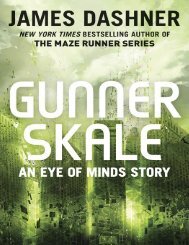32896589326509350
You also want an ePaper? Increase the reach of your titles
YUMPU automatically turns print PDFs into web optimized ePapers that Google loves.
ut nothing else amiss. Neurologically, she was completely normal—a strong-minded old<br />
lady, very vigorous for her years. I reassured her about her brain and mind; she seemed,<br />
indeed, to be quite sane. I explained to her that hallucinations, strangely, are not<br />
uncommon in those with blindness or impaired sight, and that these visions are not<br />
“psychiatric” but a reaction of the brain to the loss of eyesight. She had a condition<br />
called Charles Bonnet syndrome.<br />
Rosalie digested this and said she was puzzled as to why she had started having<br />
hallucinations now, after being blind for several years. But she was very pleased and<br />
reassured to be told that her hallucinations represented a recognized condition, one that<br />
even had a name. She drew herself up and said, “Tell the nurses—I have Charles Bonnet<br />
syndrome.” Then she asked, “Who was this Charles Bonnet?”<br />
C<br />
harles Bonnet was an eighteenth-century Swiss naturalist whose investigations<br />
ranged broadly, from entomology to reproduction and regeneration in polyps and<br />
other animalcules. When an eye disease made his beloved microscopy impossible, he<br />
turned to botany—he did pioneer experiments on photosynthesis—then to psychology,<br />
and nally to philosophy. When he heard that his grandfather Charles Lullin had started<br />
to have “visions” as his eyesight failed, Bonnet asked him to dictate a full account.<br />
John Locke, in his 1690 Essay Concerning Human Understanding, put forward the<br />
notion that the mind is a tabula rasa until it receives information from the senses. This<br />
“sensationalism,” as it was called, was very popular with the philosophes and<br />
rationalists of the eighteenth century, including Bonnet. Bonnet also conceived of the<br />
brain as “an organ of intricate composition, or rather an assemblage of dierent<br />
organs.” These dierent “organs” all had their own dedicated functions. (Such a modular<br />
view of the brain was radical at the time, for the brain was still widely regarded as<br />
undierentiated, uniform in structure and function.) Thus Bonnet attributed his<br />
grandfather’s hallucinations to continuing activity in what he postulated were visual<br />
parts of the brain—an activity drawing on memory now that it could no longer draw on<br />
sensation.<br />
Bonnet—who would later experience similar hallucinations when his own eyesight<br />
declined—published a brief account of Lullin’s experiences in his 1760 Essai analytique<br />
sur les facultés de l’âme, a book devoted to considering the physiological basis of various<br />
senses and mental states, but Lullin’s original account, which lled eighteen pages of a<br />
notebook, was subsequently lost for nearly 150 years, coming to light only at the<br />
beginning of the twentieth century. Douwe Draaisma has recently translated Lullin’s<br />
account, including it in a detailed history of Charles Bonnet syndrome in his book<br />
Disturbances of the Mind. 1<br />
Unlike Rosalie, Lullin still had some eyesight left, and his hallucinations were<br />
superimposed on what he saw in the real world. Draaisma summarized Lullin’s account:<br />
In February 1758, strange objects had begun to oat into his eld of vision. It<br />
started with something that resembled a blue handkerchief, with a small yellow

















